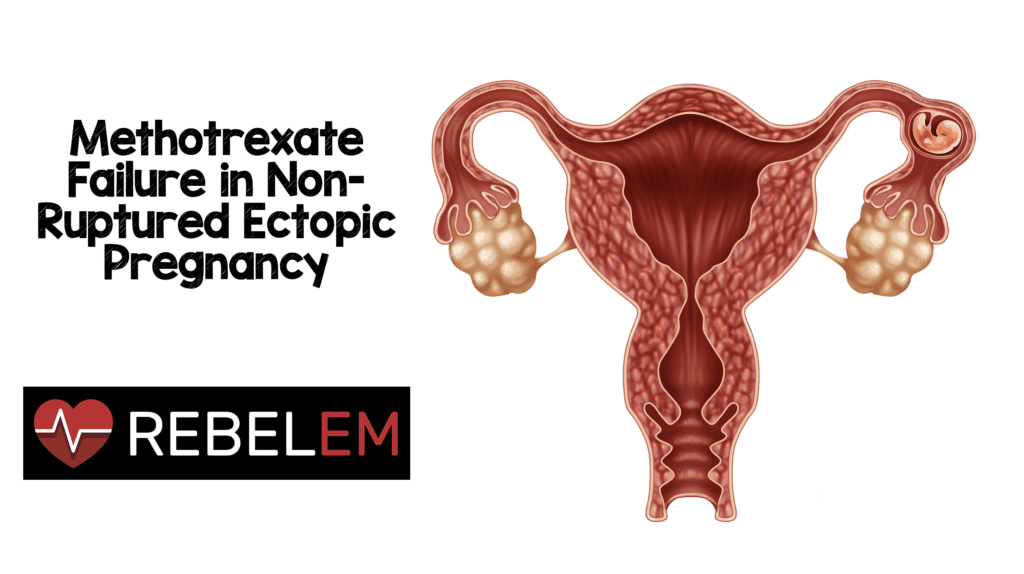
 Background: 1st trimester vaginal bleeding and abdominal pain is a common complaint seen in the ED. As EM physicians it is important to make the diagnosis of ectopic pregnancy early in the clinical course as it can prevent rupture, difficulty with future fertility, and even death. Typically, when non-ruptured, hemodynamically stable, ectopic pregnancy is diagnosed, our Ob/Gyn colleagues get consulted and the usual first-line treatment is methotrexate initiated in the ED with 24 – 72hours follow-up in an ideal world. Unfortunately, this does not always happen, and some patients will return to the ED for increased pain. It is important to be aware of methotrexate outcomes and have suspicion for failure of methotrexate in patients returning to the ED.
Background: 1st trimester vaginal bleeding and abdominal pain is a common complaint seen in the ED. As EM physicians it is important to make the diagnosis of ectopic pregnancy early in the clinical course as it can prevent rupture, difficulty with future fertility, and even death. Typically, when non-ruptured, hemodynamically stable, ectopic pregnancy is diagnosed, our Ob/Gyn colleagues get consulted and the usual first-line treatment is methotrexate initiated in the ED with 24 – 72hours follow-up in an ideal world. Unfortunately, this does not always happen, and some patients will return to the ED for increased pain. It is important to be aware of methotrexate outcomes and have suspicion for failure of methotrexate in patients returning to the ED.
What They Did:
- Retrospective chart review of pregnant first trimester (<12 weeks gestational age) women from a single center ED with diagnosis of ectopic pregnancy, rule out ectopic pregnancy, or pregnancy of unknown location over a 7-year period
Outcomes:
- Primary: Proportion of women who failed medical management with methotrexate after being discharged from the ED
Inclusion:
- Pregnant (<12 weeks’ gestational age)
- Adults (≥18 years)
- Treated with methotrexate
- Discharged from the ED
Exclusion:
- Non-tubal ectopic pregnancies
- Ruptured ectopic pregnancy
- Duplicate entries
- Not pregnant
- Locked record
- Missing record
Results:
- 612 patients with suspected ectopic pregnancy
- 238 patients diagnosed with tubal ectopic pregnancy
- 152 (63.9%) treated with methotrexate at index ED visit or follow-up
- 27 (17.8%) went on to require surgical management
- 17 (11.2%) documented as having ruptured ectopic pregnancy on surgical evaluation
- 20 (13.1%) patients had at least one relative contraindication for receiving methotrexate (pre-treatment bHCG level >5000mIU/mL), presence of fetal cardiac activity, ectopic pregnancy size >4cm)
- 5/20 (25.0%) had an ectopic rupture
- 3/20 (15.0%) had non-urgent surgical management
- 12/20 (60%) had successful medical management
- 132 patients received methotrexate without relative contraindications
- 12 (9.1%) had ectopic pregnancy rupture
- 7 (5.3%) required surgical management
- 111 (84.1%) had successful medical management
Strengths:
- Asks a clinically important question
- Trained research personnel reviewed medical records and extracted data
- Tertiary center with comprehensive outcome data on all but 2 included patients.
Limitations:
- Retrospective study, only what was documented in patient charts can be reported. It is possible clinical management may have been decided by information not documented in the chart
- Single center study, with easy access early pregnancy clinic that sees patients (within 24 – 72hrs), which may limit generalizability to other hospital systems
- Unclear if patients were non-adherent with follow up or subsequent dosing of medications
- Several patients received methotrexate despite having one or more relative contraindications to methotrexate treatment, which inflates the failure rate
- Search terms used were not comprehensive (i.e. first trimester bleeding, vaginal bleeding, pregnancy, miscarriage, etc…)
- Patient preferences not available (i.e. patients may have preferred methotrexate despite relative contraindications over surgery)
Discussion:
- Physicians should have a higher index of suspicion of ruptured ectopic pregnancy in patients treated with methotrexate upon return ED visits with the following relative contraindications:
- Pre-treatment bHCG level >5000mIU/mL
- Presence of fetal cardiac activity
- Ectopic pregnancy size >4cm
Author Conclusion:
“The proportion of patients failing methotrexate as first-line treatment was higher than previously reported. Further investigation is needed to determine whether methotrexate failure was due to non-adherence to recommended guidelines.”
Clinical Take Home Point: Despite the authors quoting a 17.8% failure rate with medical management of non-ruptured, hemodynamically stable, ectopic pregnancy with methotrexate, a more appropriate statement would be that in patients who received methotrexate without relative contraindications (pre-treatment bHCG level >5000mIU/mL, presence of fetal cardiac activity ectopic pregnancy size >4cm), 12 (9.1%), had an ectopic rupture, which is a more accurate estimation.
Expert Peer Review

Jessica Pescatore, DO
Attending Obstetrician/Gynecologist
Jefferson OB/GYN Associates
Mullica Hill, NJ
First trimester bleeding occurs in approximately 20-40% of pregnancies, which may prompt patients to seek ER evaluation. Of these, most are secondary to threatened or spontaneous abortion. However, the most worrisome cause of first trimester bleeding and one that must always be on a provider’s differential is that of ectopic or tubal pregnancies. These only account for approximately 2% of all first trimester bleeding, but if misdiagnosed or mistreated, can have catastrophic outcomes.
Treatment of ectopic pregnancy can range from expectant management (rare but used on case-by-case basis), medical (methotrexate) and surgical (salpingostomy, salpingectomy). The optimal treatment depends on a variety of factors, including patient reliability and compliance with laboratory testing and office visits, relative contraindications to medical therapies (HCG level, fetal cardiac activity, ectopic size), absolute contraindications (hypersensitivity to drug, renal or hepatic lab abnormalities), clinical exam findings and patient preference.
In this paper, the authors used a retrospective chart review to assess the outcomes of patients diagnosed and treated for an ectopic pregnancy using methotrexate. Medical therapy with methotrexate has a success rate of approximately 90% in treating diagnosed tubal pregnancies with minimal side effects. These authors found that the failure rate of methotrexate was slightly higher in their patient population (17.8%), however this does not parse out patients who had one or more “relative” contraindications to this type of management. In the patient population without any contraindications, failure rate of methotrexate was closer to the standard (9.1%).
I think it is important to reiterate that although a patient may have a relative contraindication to methotrexate; it does not preclude her from receiving this therapy. Rather, it emphasizes the need for clinicians to have detailed discussions with their patients regarding worrisome signs and symptoms for which to return to the ER for evaluation. In addition, patients should be counselled that while success rates can be as high as 90%, there is still a risk for tubal rupture, which would require emergent surgical intervention.
References:
- Harylyshyn K et al. Methotrexate for the Treatment of Unruptured tubal Ectopic Pregnancy. CJEM 2018. PMID: 30295218
Post Peer Reviewed By: Rick Pescatore, DO (Twitter: @Rick_Pescatore)
The post Methotrexate Failure in Non-Ruptured Ectopic Pregnancy appeared first on REBEL EM - Emergency Medicine Blog.
